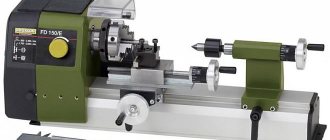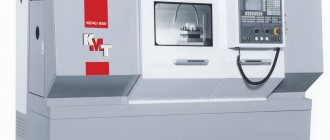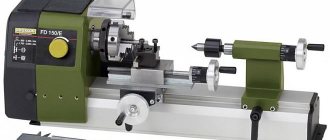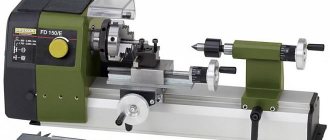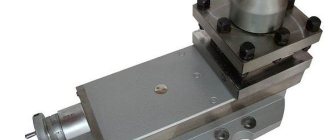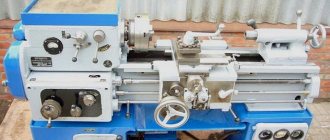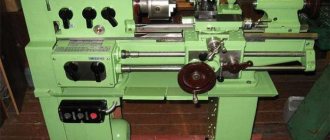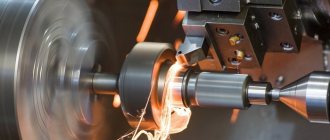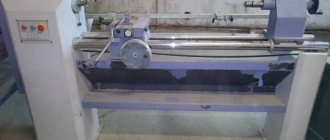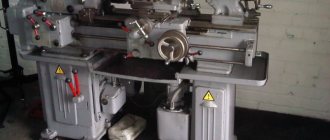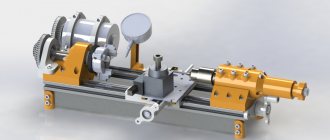SHARE ON SOCIAL NETWORKS
FacebookTwitterOkGoogle+PinterestVk
A metal lathe for home is a device that is a miniature copy of a factory unit and is used to perform various technological operations. The compactness of this machine allows it to be placed in a small home workshop or garage. This article discusses the main types of small-sized machines, their technical characteristics, and also provides advice on selection.
Small-sized models of lathes are used not only in home workshops, but also in small industries
Types of lathes for metal processing
The main factor that influences the choice of such equipment for the home is its purpose. Before purchasing such a small machine, you need to know exactly what it will be used for.
Depending on the purpose, all turning units are divided into three main types:
- desktop;
- semi-professional;
- professional.
In production, powerful metal-working units are used; smaller models are more suitable for domestic purposes.
Desktop devices for private use at home are distinguished by their small dimensions and, accordingly, weight. The minimum weight of such micro-machines is 13 kg, and the maximum does not exceed 100 kg. In turn, semi-professional floor options, which are also often used in home workshops, can weigh up to 400 kg. The power of the desktop unit reaches 400 watts.
Semi-professional machines are also used in small industries and are distinguished by higher power (up to 1000 watts) and functionality. As a rule, such units combine, in addition to turning functions, two more: drilling and milling. This expansion of capabilities significantly increases the functionality of the machines.
Professional units are installed in large and medium-sized industries. They are often controlled by software. They are large in size and weight.
Only the first type of machine is suitable for use at home. Depending on the method of processing parts, they are divided into three main types:
- turning and milling;
- screw-cutting lathes;
- combined.
Each type of machine has its own set of functions and technical characteristics
Metal turning and milling machines are used, as a rule, for removing chamfers from workpieces, as well as for organizing holes and facing. The second type of desktop devices is used for sharpening parts and applying threads to them. In turn, combined devices used at home are capable of performing all of the above functions.
Drilling machines. Boring machines
- 2A106P
drilling table Ø 6, Molodechno - 2A112
table drill Ø 12 - 2A125
vertical drilling Ø 25, Sterlitamak - 2A135
vertical drilling Ø 35, Sterlitamak - 2A150
vertical drilling Ø 50, Sterlitamak - 2B118
vertical drilling Ø 18, Vitebsk - 2B125
vertical drilling Ø 25, Krasnorechensk - 2G103P
table drill Ø 3, Kalyazin - 2G106P
table drill Ø 6, Yerevan - 2G125
vertical drilling Ø 25, Krasnorechensk - 2G175
vertical drilling Ø 75, Sterlitamak - 2L125
vertical drilling Ø 32, Lipetsk - 2M103P
drilling table Ø 3, Kirovakan - 2M112
drilling table Ø 12, Kirov, (Selmash) - 2M118
drilling table Ø 18, Orenburg - 2N106P
drilling table Ø 6, Molodechno - 2N112
drilling table Ø 12, Perm - 2N115pm
drilling table Ø 15, Perm - 2N118
vertical drilling Ø 18, Molodechno - 2N118-1
vertical drilling Ø 18, Molodechno - 2N125
vertical drilling Ø 25, Sterlitamak - 2N125L
vertical drilling Ø 25, Molodechno - 2N135
vertical drilling Ø 35, Sterlitamak - 2N150
vertical drilling Ø 50, Sterlitamak - 2Р135Ф2
vertical drilling machine with CNC Ø 35, Sterlitamak - 2С50
vertical drilling Ø 50, Sterlitamak - 2S108P
drilling table Ø 8, Molodechno - 2С118
drilling table Ø 18, Chelyabinsk - 2S125MP
vertical drilling Ø 25, Orenburg - 2S125, 2S125-1 (2S125-01), 2S125-04
vertical drilling Ø 25, Sterlitamak - 2С132, 2С132К
vertical drilling Ø 32, Sterlitamak - 2СС1м (2СС1)
drilling table Ø 6, Saratov - 2T118
vertical drilling Ø 18, Gomel, GSZU - 2T125
vertical drilling Ø 25, Gomel, GSZU - 2T140
vertical drilling Ø 40, Gomel, GSZU - 2T150
vertical drilling Ø 50, Gomel, GSZU - 2118
vertical drilling Ø 18, Novocherkassk - 2135
vertical drill Ø 35, Sterlitamak - AS2116m
drilling table Ø 16, Astrakhar - VSN
drilling table Ø 16, Kasimov - VSN-12
desktop thread-cutting machine M3..M8, Vitebsk - GS-520
drilling table Ø 16, Gomel, (GZSU) - GS2112
drilling table Ø 12, Gomel, (GZSU) - GS2116k
drilling table Ø 18, Gomel, (GZSU) - EM-102
drilling table Ø 12, Saratov - ZIM-426
drilling table Ø 6, Novosibirsk - ZIM-427
drilling table Ø 6, Novosibirsk - Corvette-42
drilling table Ø 16, Voronezh - Corvette-44
drilling table Ø 16, Voronezh - Corvette-45
drilling table Ø 13, Voronezh - Corvette-46
drilling table Ø 16, Voronezh - Corvette-47
drilling table Ø 16, Voronezh - Corvette-48
drilling table Ø 16, Voronezh - KS-02
drilling coordinate Ø 12, Kaunas - MS-36
drilling magneticØ 40, Grodno - MS-51
drilling magneticØ 51, Grodno - NS-12
drilling table Ø 12 - NS-12A
drilling table Ø 12, Vilnius - NS-12B
drilling table Ø 12 - NS-16
drilling table Ø 16, Rostov-on-Don - NS-23
drilling table Ø 23, Chelyabinsk - NS-Sh
drilling table Ø 12, Novocherkassk - NSP-2
drilling table Ø 6, Riga - NSF-1
desktop drilling and milling Ø 12, Chelyabinsk - NSF-23
desktop drilling and milling Ø 23, Chelyabinsk - R-175, R-175m
drilling table Ø 16, Chistopol - S-25
table drill Ø 5, Kalyazin - S-106
drilling table Ø 3, Kalyazin - S-155
drilling table Ø 3, Kirovakan - SV-20
tabletop drilling five-spindle Ø 14, Yoshkar-Ola - SNVSH
tabletop drilling Ø 16, Rostov-on-Don - SNVSH-2
drilling table Ø 16, Rostov-on-Don - SNS-12
drilling table Ø 12, Alapaevsk - SUS-1
drilling table Ø 12, Vilnius - SF-1
drilling and milling tabletop Ø 23, Orsha - SF-16, SF-16-02, SF-16-05
drilling and milling tabletop Ø 16, Sterlitamak - TMNS-12
drilling table Ø 12, Tchaikovsky - 2A430
jig boring machine 280 x 560, Kaunas - 2A450
coordinate boring machine 630 x 1100, Moscow (MZKRS), Kuibyshev - 2A470
coordinate boring two-column 1400 x 2240, Leningrad, (Sverdlov) - 2B440A
jig boring machine 400 x 800, Kuibyshev, Samara - 2B460
coordinate boring two-column 1000 x 1600, Leningrad, (Sverdlov) - 2D450
coordinate boring machine 630 x 1120, Moscow (MZKRS) - 2E440A
jig boring machine 400 x 710, Kuibyshev, Samara - 2E450
coordinate boring machine 630 x 1120, Moscow (MZKRS) - 2E450AF1
coordinate boring machine 630 x 1120, Moscow (MZKRS) - 2E450AF30
CNC coordinate boring machine 630 x 1120, Moscow (MZKRS) - 2E460
coordinate boring two-column 1000 x 1600, Leningrad, (Sverdlov) - 2E470
coordinate boring two-column 1400 x 2240, Leningrad, (Sverdlov) - 24K40SF4
jig boring machine 400 x 800, Kuibyshev, Samara - 2421
jig boring machine 250 x 450, Kaunas - 2431
coordinate boring 320 x 560, Kaunas - 2431sf10
jig boring machine 320 x 560, Kaunas - 2450
coordinate boring 630 x 1100, Moscow (MZKRS) - 2455
jig boring machine 630 x 900, Kuibyshev - KR-450
coordinate boring two-column 380 x 520 - 2A53
radial drilling Ø 35, Odessa - 2A55
radial drilling Ø 50, Odessa - 2A554
radial drilling Ø 50, Odessa - 2A576, 2A587
radial drilling Ø 80, Odessa - 2A592
radial drilling Ø 25 x 130, Vitebsk - 2B56
radial drilling Ø 50, Kharkov - 2E52
radial drilling portable Ø 25, Gomel, (GZSU), Oktemberyan (Gyumri) - 2K52, 2K52-1
radial drilling portable Ø 25, Gomel, (GZSU) - 2K522
radial drilling portable Ø 32, Gomel, (GZSU) - 2K550V
radial drilling Ø 55, Gomel, (GZSU) - 2L53
radial drilling Ø 35, Oktemberyan (Gyumri) - 2L53U
radial drilling Ø 35, Oktemberyan (Gyumri) - 2M55
radial drilling Ø 50, Odessa - 2M57
radial drilling Ø 75, Odessa - 2M58
radial drilling Ø 100, Ivanovo - 2Н55
radial drilling Ø 50, Odessa - 2Р53
radial drilling Ø 35, Odessa - 2С550А
radial drilling Ø 36, Sterlitamak - 255
radial drilling Ø 50, Odessa - 257
radial drilling Ø 75, Odessa - 2532l
radial drilling Ø 32, Oktemberyan (Gyumri) - GS545
radial drilling portable Ø 45, Gomel, (GZSU) - SRB50
radial drill Ø 50, Sterlitamak - 2А614
horizontal boring Ø 80 Charentsavan - 2A620
horizontal boring machine Ø 90, Leningrad, (Sverdlov) - 2А620Ф1
horizontal boring machine Ø 90, Leningrad, (Sverdlov) - 2А620Ф2
horizontal boring machine Ø 90, Leningrad, (Sverdlov) - 2A622
horizontal boring Ø 110, Leningrad, (Sverdlov) - 2А622Ф1
horizontal boring machine Ø 110, Leningrad, (Sverdlov) - 2A622F2
horizontal boring machine Ø 110, Leningrad, (Sverdlov) - 2А622Ф4
horizontal boring machine Ø 110, Leningrad, (Sverdlov) - 2A636
horizontal boring Ø 125, Ivanovo - 2А636Ф1
horizontal boring Ø 125, Ivanovo - 2A637
horizontal boring Ø 160, Ivanovo - 2А656Ф11
horizontal boring Ø 160, Leningrad, (Sverdlov) - 2V622F4
horizontal boring machine Ø 125, Leningrad, (Sverdlov) - 2E656
horizontal boring machine Ø 160, Leningrad, (Sverdlov) - 2L614
horizontal boring machine Ø 80, Charentsavan - 2M614
horizontal boring machine Ø 80, Charentsavan - 2N636GF1
horizontal boring Ø 125, Kolomna - 262g
horizontal boring machine Ø 85, Leningrad, (Sverdlov) - 2620, 2620A
horizontal boring Ø 90, Leningrad, (Sverdlov) - 2622, 2622A
horizontal boring Ø 110, Leningrad, (Sverdlov) - 2611F2
horizontal boring machine with CNC Ø 80, Ivanovo - 2620V
horizontal boring Ø 90, Ivanovo - 2622V
horizontal boring Ø 110, Ivanovo - 2636
horizontal boring Ø 125, Ivanovo - 2657
horizontal boring Ø 150, Leningrad, (Sverdlov) - 2A78
finishing and boring 500 x 1000, Maykop - 2А78Н
finishing and boring machine 500 x 1250, Maykop - 2E78P, 2E78PN
finishing and boring machine 500 x 1000, Maykop - 2G942
milling-central-turning Kostroma - 278
finishing and boring 500 x 1000, Maykop - 2054m
thread-cutting machine M8, Molodechno, Krasnorechensk - 2056
thread-cutting machine M18, Molodechno - 2733P
finishing and boring machine 630 x 1250, Maykop - A9518
thread rolling 63 kN, Ø 3..45, AZKPA - MR-71M
milling and centering Kostroma - UPW 12.5 x 70
thread rolling 125 kN, Ø 3..70, GDR - UPW 25 x 100
thread rolling 250 kN, Ø 10..100, GDR
2.1. Vertical and benchtop drilling machines
2.4. Jig boring machines
2.5. Radial drilling machines
2.6. Horizontal boring machines
2.7. Finishing boring machines and special
Features of tabletop metal lathes
Such units are suitable for processing metal parts that are small in size. Using such a unit allows you to perform the following operations:
- turning parts in the shape of a cylinder or cone;
- trimming the ends of parts;
- grinding;
- organizing holes by drilling;
- expansion of holes;
- threading (both external and internal).
Helpful information! Processing of various parts on a home lathe is carried out at a much lower speed than on professional equipment. However, this does not in any way affect the quality of the finished product, especially if the operation of the unit is controlled using a computer numerical control (CNC) system.
Small-sized lathes are used to perform various technological metalworking operations at home
Small devices of this type are capable of performing many functions. They have found their application not only at home, but also in small workshops, as well as in car repair shops. Since Soviet times, such mini-machines have been used to teach turning to schoolchildren and students of professional technical institutions.
Thus, small-sized turning units are used for different purposes. They are indispensable and useful devices that allow technical operations with small parts. You can buy a metal lathe for your home in any specialized store or on the Internet.
Why is it necessary in everyday life?
We can say that home lathes are small copies of professional ones, which makes it easy to learn the specifics of working on it and the processing process itself.
A home lathe, of course, does not have the dimensions and technical features of professional equipment used in large workshops and industries. But with the help of this device you can easily carry out all the necessary work on processing external/internal surfaces, cutting threads, carrying out milling operations and drilling.
For work in a home workshop, small-sized machines are usually used, which have less power and options. But the quality of the products does not change and remains at a high level.
The main advantages of a home metal cutting machine are:
Affordable price. Thanks to the low price, many people can afford the necessary household items.- Reduced noise and vibration levels.
- Increased device rigidity.
- Ease of operation and further maintenance of the machine.
- The presence of already polished beds (they are fixed on the machine in a certain way).
- Excellent processing accuracy. This is achieved through the use of precision roller bearings in the design.
After purchasing such a device, the owner no longer has to think about who to contact to manufacture or process the necessary part. This increases the return on investment of the machine, since you will not need to contact service centers, workshops or factories.
Having become the owner of a home metal processing machine, the owner may not even remember problems such as:
- difficulties when forming threads with different pitches (internal or external);
- difficulties with turning an object to the specified size and shape;
- the question of where to bore the blanks;
- trim the side edges of the product;
- drill holes, connectors of various diameters;
- Carefully trim off excess iron elements.
Expert opinion
Levin Dmitry Konstantinovich
Using a home lathe, you can make a product that is ideal in size, shape and quality, practically indistinguishable from a factory one.
Advantages of mini lathes
Units of this type have a number of advantages over large-sized, professional devices. For example, to operate such equipment, a standard household electrical network with a voltage of 220 V is sufficient. If desired, the mini-machine can be adapted to connect to a network with a voltage of 380 V (three-phase).
Another important advantage of a home turning unit is that it consumes a small amount of electricity during operation. The shelf life of micromachines of this type can reach several decades. How long it will serve you directly depends on two factors: proper use and timely maintenance.
To extend the service life of the metalworking unit, technical inspections and maintenance should be carried out regularly.
Due to its compactness, such a micro-machine can be placed in any suitable room (room in an apartment, garage, etc.). Units of this type allow novice turners to quickly learn how to process metal parts. It’s also worth saying that the cost of lathes for home use is more than affordable for most people.
And finally, an important advantage of such devices is that they can be equipped with additional devices. This allows them to be used for milling metal parts, which significantly expands their operational range.
Classification of machines according to possible processing material
All production machines are divided according to their technical characteristics, based on the material of the workpieces that they will process. Thus, metal and wood are considered the main materials with which machine tools work. Machines with weaker power ratings are suitable for working with wooden workpieces. But, on the other hand, woodworking machines should be provided with more flexible settings for operations. As for metalworking machines, they require higher power and a reliable element base. The most popular are turning, milling and drilling machines.
Construction of a mini metal lathe
From a constructive point of view, such units are quite complex devices, since they copy industrial machines. Let's look at the main components:
- bed;
- spindle (front) assembly or headstock;
- caliper
At home, universal units are more often used.
The bed is the basis of any machine, which is equipped with holes for fixing to the working surface (for example, a table). As a rule, this element is made of cast iron and is equipped with guides for other components.
The support performs two important functions, namely: fixing the processing tool and changing its position during operation. The following processing devices can be used:
- drill;
- cutter;
- countersink.
The front assembly includes the electric motor, spindle, drive and gearbox. Thanks to these components, the shaft rotates and this effect is transmitted to the second unit.
In most cases, the drive of a home lathe used for processing metal parts is driven by a V-belt. Some units have a speed control function. To do this, the V-belt is rearranged from one pulley cavity to another.
Note! Sometimes, to provide more precise speed settings, the mini-machine is equipped with an additional electric-type controller. The undeniable advantage of a belt drive is that its presence reduces the risk of motor burnout if the workpiece jams.
Most modern machine models are equipped with information plaques indicating the necessary settings for performing certain operations.
The smallest lathes often have a support with limited functionality installed. It is a cutter holder that has one place and two positions. The machining fixture in such an element can only be used for boring or external turning. It follows from this that to perform other work it will be necessary to change the cutters themselves, as well as their position.
Design features of school metal lathes
The design of lathes used for teaching in schools is usually classical. The differences between devices are determined by their purpose and functional features. There are two types of school mini-looms, depending on their design:
- desktop;
- floor
They include a frame, which is made of cast iron or steel metal sheets. The main units of the unit are installed on it, namely: the front unit (headstock), rear unit, cutter clamp, and caliper. There are some design features of school units that are due to the simplicity of the design. Let's look at them:
- school lathes are not equipped with a gearbox;
- speed change is carried out via a belt drive;
- the spindle head has a simpler design;
- the base of the unit does not have a special recess, which is designed for working with large parts.
In such devices, the flow of liquid necessary for cooling the equipment is carried out through an integrated system. If there is none, then the cutting fluid is applied manually.
In home workshops, along with used machines made in the USSR, imported training machines are often used
Mini-machines for processing metal workpieces must have one more important element - a mechanical brake. It is necessary in order to reduce the percentage of defects during the processing of metal parts.
In amateur workshops, which are often located in garages, school mini-machines are often used. There are three main types of such small units.
Features of a metal lathe for the TV-4 garage
This type of unit is one of the most popular and widespread in the CIS. The active use of such a machine in schools began in Soviet times. It was then that they began to call it “training TV-4”. However, the functionality of this unit allows it to be used for a variety of tasks.
The main advantage of TV-4 is its compactness. Thanks to this, such devices are still used in home workshops. To process various metal parts in the garage, not only desktop devices are used, but also those that have their own base.
Characteristics of the TV-4 lathe (floor-mounted):
- power indicator is 1 kW;
- required electrical network voltage – 220 V;
- the maximum length of a part that can be processed on such a unit is 30 cm;
- maximum cross-section of the workpiece – 200 mm;
- number of revolutions per minute – up to 710;
- weight – about 280 kg.
The functionality of the TV-4 lathe allows it to be used for a variety of tasks
Helpful information! You can purchase such a model in any online store, where there are many offers for the sale of not only entire units of this type, but also their components. True, you will have to buy a used device, since it is almost impossible to find a model that has not been used.
The price of a TV-4 lathe varies from 25,000 to 65,000 rubles. Its cost is influenced by the condition and functionality of the structure.
Characteristics of TV-6 screw-cutting lathes
A unit of this type was also actively used in schools in the USSR. TV-6 is used to perform the simplest technical operations, including:
- drilling holes;
- trimming ends;
- cutting off part of a part;
- applying metric threads;
- boring of workpieces (cylindrical and conical).
TV-6 mini-machines are used for processing parts made of non-ferrous metals or steel. Limited capabilities are due to the fact that processing products made from other materials leads to dust in the room in which the unit is located. The release of dust can be harmful to the health of the technician.
Let's look at the main characteristics of this model:
- power indicator is 1.1 kW;
- the electrical network voltage required for the operation of the machine is 220 V;
- the maximum length of the part for processing is 35 cm;
- the maximum cross-section of the workpiece that can be worked with is 200 mm;
- number of revolutions per minute – up to 700;
- weight – about 300 kg.
One of the undeniable advantages of “school” models of lathes is their relative compactness
Despite the fact that the maximum length of a product that can be processed on TV-6 is 35 cm, the length of the part being grooved is only possible within a gap of 30 cm.
Small dimensions are a big advantage of this metal lathe. You can buy a used model of this type for 35,000-70,000 rubles. TV-6 is perfect for working with metal parts in a home workshop.
TV-7 machines: main differences from TV-6
A turning unit of this type is an improved version of the TV-6 device. The main differences between these two models are the gearbox design. It’s also worth saying that TV-7 differs from TV-6 in the design of the spindle head.
Related article:
Metal cutters for a lathe: detailed characteristics of the tool
Design features. Classification of tools depending on various factors. Rules for sharpening cutters.
Let's look at the main characteristics of the TV-7 mini-machine:
- power indicator is 1.1 kW;
- required network voltage – 220 V;
- the maximum length of the workpiece for processing is 33 cm;
- the largest diameter of the workpiece with which this unit can work is 220 mm;
- number of revolutions per minute – up to 1000;
- weight – 400 kg.
Helpful information! The gearbox of such a mini-machine, used for processing metal parts, can operate in two modes. It is also worth noting that TV-7 has one more difference from earlier school units, namely: the absence of levers necessary to change gears.
The simple control system of the TV-7 machine allows even those who have little experience in metalworking to cope with turning work.
The price of a metal lathe of this type ranges from 55,000 to 85,000 rubles. As in previous cases, purchasing a new device is extremely difficult, so the choice must be made among used models.
Grinding machines
- 3A10P
cylindrical grinder Ø 15, St. Petersburg, SPZPS - 3A110
cylindrical grinder Ø 140, Tbilisi - 3A130
cylindrical grinder Ø 280, Lubny - 3A151
cylindrical grinder Ø 200 Kharkov - 3A161
cylindrical grinder Ø 280 Kharkov - 3A164
cylindrical grinder Ø 400, Kharkov - 3A184
centerless cylindrical grinder Ø 80, Vitebsk - 3B12
cylindrical grinding machine Ø 200, Vilnius, Leninokan (Gyumri) - 3B151
cylindrical grinder Ø 200, Kharkov - 3B153
cylindrical grinder Ø 140, Vilnius - 3B161
cylindrical grinder Ø 280, Kharkov - 3B10
cylindrical grinder Ø 100, Vilnius - 3E12
cylindrical grinder Ø 200, Vilnius - 3D180
centerless cylindrical grinder Ø 1..12, Vitebsk - 3E180V
centerless cylindrical grinder Ø 1..10, Vitebsk - 3E183
centerless cylindrical grinder Ø 40, Vitebsk - 3E184
centerless cylindrical grinder Ø 80, Vitebsk - 3K12
cylindrical grinder Ø 200, Leninokan (Gyumri) - 3M131
cylindrical grinder Ø 280, Lubny - 3M132v
cylindrical grinder Ø 280, Kharkov - 3M151
cylindrical grinder Ø 200, Kharkov - 3M152
cylindrical grinder Ø 200, Kharkov - 3M162
cylindrical grinder Ø 280, Kharkov - 3M151F2
CNC cylindrical grinder Ø 200, Kharkov - 3M153
cylindrical grinder Ø 140, Vilnius - 3M174
cylindrical grinder Ø 400, Lubny - 3M175
cylindrical grinder Ø 400, Lubny - 3M182
centerless cylindrical grinder Ø 25, Vitebsk - 3M184
centerless cylindrical grinder Ø 80, Vitebsk - 3M193
cylindrical grinder Ø 560, Kharkov - 3M194
cylindrical grinder Ø 560, Kharkov - 3M196
cylindrical grinder Ø 800, Kharkov - 3M197
cylindrical grinder Ø 800, Kharkov - 3U10A
cylindrical grinder Ø 100, Vilnius - 3U12af11
cylindrical grinder Ø 200, Vilnius - 3U12vf11
cylindrical grinder Ø 200, Leninakan - 3U131
cylindrical grinder Ø 280, Lubny - 3U132
cylindrical grinder Ø 280, Lubny - 3U133
cylindrical grinder Ø 280, Lubny - 3U142
cylindrical grinder Ø 400, Lubny - 3U143
cylindrical grinder Ø 400, Lubny - 3U144
cylindrical grinder Ø 400, Lubny - 312M
cylindrical grinder Ø 200, St. Petersburg, SPZPS - 3130
cylindrical grinder Ø 280, Kharkov - 3131
cylindrical grinder Ø 280, Lubny - 3132
cylindrical grinder Ø 280, Kharkov - 3151
cylindrical grinder Ø 150, Kharkov - 3180
centerless cylindrical grinder Ø 75, Moscow - 3184
centerless cylindrical grinder Ø 75, Vitebsk - B-88
cylindrical grinder Ø 140, Leningrad - KSh-400
ultra-high precision cylindrical grinder Ø 200 × 400 - 3A227, 3A227P
internal grinding Ø 400, Saratov - 3A228
internal grinding Ø 200, Voronezh - 3K227A
internal grinding Ø 400, Saratov - 3K227V
internal grinding Ø 400, Saratov - 3K228A
internal grinding Ø 400, Voronezh, Saratov - 3K228V
internal grinding Ø 400, Voronezh, Saratov - 3K229A
internal grinding Ø 800, Voronezh, Saratov - 3M227VF2
internal grinding machine with CNCØ 400, Saratov - 32K84SF4
coordinate grinding machine with CNC - 3A423
cylindrical grinder for regrinding crankshaft journals Ø 580, Lubny - 3B423
cylindrical grinder for regrinding crankshaft journals Ø 580, Lubny - 3D4230
cylindrical grinder for regrinding crankshaft journals Ø 580, Lubny - 3451
grinding machine Moscow, MSZ - 3A64
sharpening Ø 250 x 650, Vitebsk - 3А64М
sharpening Ø 250 x 650, Vitebsk - 3A64D
sharpening Ø 250 x 600, Vitebsk - 3A662
sharpening machine for hob cutters Ø 200 x 630, Vitebsk - 3B632
sharpening and grinding machine for sharpening cutters Mukachevo - 3B633
sharpening and grinding machine Ø 300, Tiraspol - 3B634
sharpening and grinding machine Ø 400, Mukachevo - 3B662VF2
sharpening machine for CNC hob cutters, Ø 200 x 630, Vitebsk - 3B641
sharpening Chita - 3B642
sharpening Vitebsk - 3B642
sharpening Vitebsk - 3D641E
grinding machine Ø 200 x 400, Vitebsk, Mukachevo - 3D642E
sharpening Vitebsk - 3D692
sharpening Vitebsk - 3E692
sharpening Vitebsk - 3E642
sharpening Vitebsk - 3E642E
sharpening Vitebsk - 3K631
sharpening and grinding machine Ø 150, Mukachevo - 3K634
sharpening and grinding machine Ø 400, Mukachevo - 3L631
sharpening and grinding machine Ø 200, Mukachevo - 3M634
roughing and grinding Saraktash - 3M636
roughing and grinding machine Armavir - 3M642
sharpening Vitebsk - 3622D
diamond sharpening machine for cutters Mukachevo - 3662
sharpening machine for hob cutters Ø 200 x 280, Vitebsk - VZ-318
sharpening Vitebsk - VZ-319
table sharpening Vitebsk - VZ-818
sharpening Vitebsk - TSH-1
tabletop sharpening and grinding machine Ø 250, Orsha - TSh-2
sharpening and grinding machine Ø 300, Orsha - TSh-3
sharpening and grinding machine Ø 400, Orsha - TSh-4
sharpening and grinding machine Ø 400, Orsha - TSh-3.20
sharpening and grinding machine Ø 400, Chelyabinsk - TS-6010S
sharpening and grinding machine Ø 49 Energomash, Sturm - TCPA-7
sharpening machine for circular, frame and band saws Kirov - ET-62
benchtop sharpening and grinding machine Ø 150, Kasimov - 3B70V
surface grinder 160 x 400, Orsha - 3B722
surface grinder 320 x 1000, Lipetsk - 3B724
surface grinder 400 x 2000, Voronezh - 3G71
surface grinder 200 x 630, Orsha - 3G71M
surface grinder 200 x 630, Orsha - 3D722
surface grinder 320 x 1000, Lipetsk - 3D725
surface grinder 630 x 2000, Voronezh - 3D711AF10-1
surface grinder 200 x 450, Orsha - 3D711VF11
surface grinder 200 x 630, Orsha - 3D756
surface grinder with vertical spindle Ø 800, Voronezh - 3E710V
surface grinder 250 x 125, Orsha - 3E711AF1
surface grinder 200 x 450, Orsha - 3E711B
surface grinder 200 x 630, Orsha - 3E711VF1
surface grinder 200 x 630, Orsha - 3E711VF2
surface grinder 200 x 630, Orsha - 3E756, 3E756L
surface grinder Ø 800, Ø 1000, Voronezh - 3L722V, 3L722A
surface grinder 320 x 1000, Lipetsk - 3L741VF10
surface grinder Ø 630, Lipetsk - 3P722V
surface grinder 320 x 1000, Lipetsk - 371
surface grinder 200 x 600, Vitebsk - 372B
surface grinder 300 x 1000, Moscow - 3711
surface grinder 200 x 630, Orsha - PSh-30540M
surface grinder 156 x 400, Tula - 3G833
honing Maikop, Krasnorechensk - 3K833
honing Maikop, Krasnorechensk - SIP-800
machine for testing abrasive wheels Derbent - 395M
profile grinding 20 x 20, Leningrad, SPZPS - 395МФ10
profile grinding with UTsI20 x 20, Leningrad, SPZPS - 3951VF1
profile grinding with digital indicator 50 x 50, Leningrad, SPZPS
3.1. Cylindrical grinding machines
3.2. Internal grinding machines
3.4. Specialized cylindrical grinding machines
3.6. Sharpening and grinding machines
3.7. Surface grinding machines
3.8. Honing machines. Special machines
Tips for buying a used machine for your home
Buying a used unit allows you to save a lot of money. However, when choosing such a product, you must be very careful not to purchase equipment that has functional problems. Let's look at the basic rules that will help you choose the right device.
When purchasing a mini-machine, it is advisable to inquire about the documentation that comes with it. If the seller does not have all the necessary documents for this equipment, then it is better to refuse to purchase a mini metal lathe. Buying a used device that is capable of processing workpieces with high precision is quite difficult, however, it is possible if desired.
Before purchasing a used mini-machine, it is recommended to check its operation. Moreover, it is necessary to test the functionality of the device in all possible modes. It is also worth paying attention to the backlash of moving parts. Clearances must comply with the technical specifications of the device.
Before purchasing a used machine, make sure that it is in working order and that all components are available, otherwise the operation of such a unit may be unsafe
Slotting, planing, broaching. Other machines. Groups 7, 8, 9
- 7210
longitudinal planer Ø 900 x 1000, Minsk - 7212
longitudinal planer Ø 1120 x 1250, Minsk - 7216
longitudinal planer Ø 1400 x 1600, Minsk - 7A33
cross-planing Orenburg - 7B35
cross-planing Orenburg - 7D36
cross planer Gomel - 7D37
cross planer Gomel - 7E35
cross planer Orenburg - 7M36
cross planer Gomel - 736
cross-planing Orenburg - 737
cross planer Gomel - 7303
cross-planing Orenburg - 7305
cross-planing Orenburg - 7307
cross-planing Orenburg - 7307G
cross planer Orenburg - 7307D, 7310d
cross planer Gomel - 7A412
slotting Ø 360, Saraktash - 7A420
slotting Ø 500, Saraktash - 749
cross-planing Orenburg - 7402
Slotting Orenburg, Baku - 7410
Slotting Minsk, MZOR - 7430
slotting Ø 650, Gomel - 7D430
slotting Ø 630, Gomel - 7D450
slotting Ø 800, Gomel - 7M430
slotting Ø 630, Gomel - 7403, 7405
— slotting Ø 630, Gomel - 7417
Slotting Orenburg - GD200
slotting Ø 500, Gomel - GD320
slotting Ø 770, Gomel - GD500
slotting Ø 940, Gomel - 7A510
broaching 98 kN, Minsk - 7B510
broaching 100 kN, Minsk - 7A534
broaching 250 kN, Minsk - 7B55
broaching 100 kN, Minsk - 7B56
broaching 200 kN, Minsk - 7523
broaching 100 kN, Minsk - 7534
broaching 250 kN, Minsk - 8A531
vertical band saw Maikop - 8A725
automatic hacksaw-cutting machine Leninakan - 8B72
cut-off saw Ø 250 Krasnodar - 8B66
automatic cutting circular saw Ø 280, Minsk - 8В66а
automatic cutting circular saw Ø 280, Minsk - 8G240
abrasive cut-off Ø 60 - 8G662
automatic cutting circular saw Ø 280, Minsk - 8G663
automatic cutting circular saw Ø 285, Minsk - 872A
cut-off saw Ø 250 Krasnodar - 872M
cut-off saw Ø 250 Krasnodar - 8535
band saw Ø 350 Kuvandyk - 8725
hacksaw Ø 250 Orenburg - N-1
hacksaw Ø 250 Kaunas
7.1. Longitudinal planing machines, single and double column
7.3. Cross planers
7.4. Slotting machines
7.5. Horizontal and vertical broaching machines
Cutting machines
Metal lathe for home with CNC control
A CNC lathe can perform the same functions as manual models. However, it performs all technological operations much faster and, most importantly, more accurately than conventional mini-devices. Thanks to the numerical software system, the possibility of errors when processing the workpiece is virtually eliminated.
The computer program ensures, if necessary, timely replacement of a functional part, and also monitors accuracy during operation of the machine. Such mini-units function almost autonomously. The wizard only needs to enter the necessary parameters in accordance with which the technological operation will be performed.
CNC machines are especially effective when performing the following types of work:
- marking;
- engraving;
- shaped sharpening.
The most popular models of CNC lathes for metal today are produced by OPTIMUM and JET. Miniature units from these brands are distinguished by high quality and accuracy of technological operations.
Metal lathes from OPTIMUM and JET companies have proven themselves to be reliable and durable units
Classification of turning equipment
The classification of lathes, which was developed back in Soviet times, classifies such units into the first category of equipment intended for processing metal workpieces. According to this classification, all types of lathes are classified into one of the following categories:
- automatic and semi-automatic turning units with one spindle;
- multi-spindle machines: automatic and semi-automatic;
- revolver models;
- cutting group machines;
- carousel models;
- frontal and screw-cutting equipment;
- multi-cutting and polishing units;
- specialized machines, which can be conventional or automatic;
- special purpose devices.
Main types of turning work
According to the degree of processing accuracy, the following types of lathes are produced:
- special accuracy - C;
- high accuracy - B;
- normal accuracy - N;
- especially high accuracy - A;
- increased accuracy - P.
Its functionality and, accordingly, its scope of application depend on the category to which the lathe belongs. You can also learn about the main technical capabilities of the machine by its marking, which includes the following:
- the initial number “1”, indicating that this is a lathe and not any other;
- a second digit indicating the type to which the turning unit belongs;
- the third digit (and in some models the fourth) is the most basic parameter of the machine, which characterizes the height of its centers.
Explanation of lathe markings (click to enlarge)
The marking of such units also contains letter designations that determine its design features: the level of its automation, accuracy, modification, and equipment with a CNC system. For example, the marking of the 1I611P lathe model is deciphered as follows: the letter “I” indicates that this is a screw-cutting lathe device; the letter “P” is a high-precision machine; The height of the centers for this model corresponds to 110 mm. You can guess what category of lathe you have in front of you by looking at the photo of the model.
Which metal lathe to buy: recommendations for choosing
When choosing a benchtop lathe, you need to pay attention to a number of important parameters. Mini-machines for home use for processing metal workpieces can have different weights. The minimum weight of such a unit is 13 kg, and the maximum is 400 kg. Accordingly, the higher the mass of the device, the larger it is.
Note! Experts recommend choosing mini-machines for home workshops that have the least weight (up to 50 kg). Such models are compact and versatile, and they are also very convenient to install. In addition, if necessary, it will not be difficult to change the location of such a small-sized unit.
Another important parameter that is worth considering when choosing a desktop mini-machine is its power. For small units this figure is no more than 2.25 kW. Separately, it is worth saying that there are devices that are commonly called “low-power”. They include a drive with a power of 0.15 kW.
Before choosing how much power you want to purchase a small-sized lathe, it is recommended to decide on its purpose. For processing small workpieces made of non-ferrous metals, less powerful tabletop metal lathes are suitable. Mini-units with higher power are suitable, in turn, for large parts made of durable material (for example, steel).
Low-power models are suitable for processing products made of non-ferrous metals
Even desktop devices intended for home workshops are complex, from a technical point of view, structures. Therefore, when choosing a mini-machine, it is also recommended to pay attention to the quality of its components. The material from which the structural elements of the device are made is of no small importance.
Experts recommend paying special attention when choosing a small-sized machine to its following components: bed and support. These elements must be made of durable metal. The outer surface of the material must be carefully sanded.
Today you can find many units of this type. To buy a mini metal lathe that is suitable for use in your case, it is recommended to study the technical characteristics of popular models of these devices on the Internet.
Recommended Specifications
Based on a number of basic technical parameters, you can choose a high-quality lathe at an affordable price:
| Parameter | Explanation | Add-ons |
| Dimensions | according to standards, the width of lathes should vary between 200-3150 cm | this is the main parameter for selection, each model has its own dimensions, which depend on the configuration |
| Weight | on average the weight of the lathe will be about 2-2.2 kg | Pay attention to the specified maximum weight of the processed products; for a part installed in a chuck, it will be about 300 kg, and for center ones it will reach up to 1.3 tons |
| Workpiece diameter | the maximum permissible (recommended) size of the workpiece passing through the spindle hole should be about 45 mm | The size of the diameter of the workpieces above the bed is also taken into account, it is equal to 40 cm, located above the support - 20-22 cm, and the size of the spindle hole should be about 45-47 mm |
| Center-to-center gap | the dimensions of the machine itself and its overall dimensions will depend on the parameters of the center-to-center distance | the intended dimensions of the device with a distance between centers of 100 cm will be about 280 cm in length and 115 cm in width, the height of the machine varies between 130-135 cm |
Choose a lathe with a drive power of at least 10 kW.
Particular attention must be paid to the engine. To make the right choice of model, determine the area of future use of the unit, and taking this data into account, make a choice in favor of a certain type of engine:
- Asynchronous . Works to convert current into mechanical power (energy). For such engines, the stator rotation speed exceeds the rotor rotation rate. The asynchronous engine model has a cast iron or aluminum frame. This class is distinguished by its large power range and popularity. Most often, machines with an asynchronous motor are chosen due to their excellent power, relatively small size and high reliability.
- Collector . The design of such an engine has a sensor (brush-commutator assembly) - a rotor position regulator, as well as a power level switch in the windings. The operation of the engine is ensured by the rotation of the shaft, which is driven by the voltage supplied to it.
Prices of tabletop metal lathes
When choosing a suitable desktop unit for your home workshop, you need to pay attention to its cost. The price of mini-machines depends on several factors, such as:
- brand;
- power;
- performance.
The cost of the machine is determined by its power, productivity, size and brand
Other, smaller characteristics of metal lathes are also reflected in pricing. The price of a mini-unit, the power of which does not exceed 500 Watts, is approximately 15,000-55,000 rubles. Such devices do not differ in functionality, but are more than fully suitable for basic tasks.
Tabletop units with a wider list of capabilities (screw-cutting lathes) cost a little more. For example, a mini-machine of this type with a power of up to 500 Watts can be purchased at a price of 27,000-75,000 rubles.
And finally, turning and milling units are considered the most expensive desktop units. The price range in this case is 65-150 thousand rubles. Depending on the functional features and technical equipment, the price of desktop metal lathes is determined. You can buy the necessary device either in a specialized store or on the Internet by placing an order online.
The most popular companies producing such equipment, as mentioned above, are OPTIMUM and JET. They produce high-quality, wear-resistant units that have a long service life. The price of such devices is quite high, however, they all correspond to the declared quality.
For example, the cost of a desktop lathe Metal Master from the JET company ranges from 50 to 150 thousand rubles. Models from the OPTIMUM brand are even more expensive (from 60 to 330 thousand rubles).
Please note that machines from little-known manufacturers, with similar characteristics, may be significantly inferior in quality and reliability to units of more well-known brands
Gear processing machines
- 5A12
gear shaping Ø 208, Yegoryevsk - 5A122
gear shaping Ø 250, Korsun-Shevchenko - 5A140P
gear shaping Ø 500, Egoryevsk - 5B150
gear shaping Ø 800, Yegoryevsk - 5B12
gear shaping Ø 200, Korsun-Shevchenko - 5B150
gear shaping Ø 800, wedge - 5M14
gear shaping Ø 500, Kharkov - 5M150
gear shaping Ø 800, wedge - 5M161
gear shaping Ø 1250, wedge - 514
gear shaping Ø 500, Yegoryevsk - 5111
gear shaping Ø 80, Korsun-Shevchenko - 5122
gear shaping Ø 200, Korsun-Shevchenko - 5140
gear shaping Ø 500, Korsun-Shevchenko - 5A26
tooth-cutting Ø 610, Saratov, SZTZS - 5A250P
tooth-cutting machine Ø 500, Saratov, SZTZS - 5S23P
tooth-cutting Ø 125, Saratov, SZZS - 5S276P
tooth-cutting Ø 500, Saratov, SZTZS - 5S280P
gear cutter Ø 800, Saratov, SZTZS - 5Т23В
tooth-cutting machine Ø 125, Saratov, SZZS - 5236P
tooth-cutting machine Ø 125, Saratov, SZZS - 525
gear cutter Ø 500, MZKRS Moscow - 526
dental planer Ø 610, Saratov, SZTZS - 5230
gear cutting machine Ø 320, Saratov, SZTZS - 528С
gear cutter Ø 800, Saratov, SZTZS - 5A342
gear hobbing Ø 2000, Kolomna - 5B310p
gear hobbing Ø 200, Vilnius - 5B312
gear hobbing Ø 320, Vitebsk - 5B312
gear hobbing Ø 320, Vitebsk - 5D32
gear hobbing Ø 800, Yegoryevsk - 5E32
gear hobbing Ø 800, Yegoryevsk - 5K32
gear hobbing Ø 800, Yegoryevsk - 5K32A, 5K324A
gear hobbing Ø 800, Yegoryevsk - 5K301p
gear hobbing Ø 125, Vilnius - 5K310
gear hobbing Ø 200, Vitebsk - 5K324
gear hobbing Ø 500, Yegoryevsk - 5K328A
gear hobbing Ø 1250, Egoryevsk - 5M32
gear hobbing Ø 800, Yegoryevsk - 53A11
gear hobbing Ø 1250, Yegoryevsk - 53A13
gear hobbing Ø 125, Vilnius - 53A20
gear hobbing Ø 200, Vilnius - 53A30P
gear hobbing Ø 320, Vitebsk - 53A50
gear hobbing Ø 500, Yegoryevsk - 53A80
gear hobbing Ø 800, Yegoryevsk - 53V30P
gear hobbing Ø 320, Vitebsk - 532
gear hobbing Ø 750, Yegoryevsk - 5310
gear hobbing Ø 200, Yegoryevsk - 5327
gear hobbing Ø 1000, Yegoryevsk - 5342
gear hobbing Ø 2000, Kolomna - 5350A
spline milling Ø 150, Kuibyshev, SVSZ - 5B63
thread milling Ø 450 x 400, Melitopol - 5D07
thread-cutting Ø 39 x 320, Chita - 561
thread milling Ø 400 x 700, Kuibyshev, SVSZ - 5993
thread-cutting machine Ø 42 x 280, Chita - VMS-2A
thread-cutting Moscow - 5A841
gear grinder Ø 320, Moscow - 5B833
gear grinder Ø 40..320, Yegoryevsk - 5D833
gear grinder Ø 40..320, Yegoryevsk - 5M841
gear grinder Ø 320, Moscow - 5K822V
thread grinding machine Ø 150, MZKRS Moscow - 5702
gear shaving Ø 320, Vitebsk - 5822
thread grinding machine Ø 150, MZKRS Moscow - 5822m
thread grinding machine Ø 150, MZKRS Moscow
5.1. Gear shaping machines for cylindrical wheels
5.2. Gear cutting and gear cutting machines for bevel wheels
5.3. Gear hobbing machines for cylindrical wheels
5.6. Thread milling, thread cutting machines
5.7. Gear and thread grinding, finishing machines
Classification of turning-screw-cutting units
The described equipment is divided into several types according to three technical characteristics:
- machine weight;
- the maximum length of the product that can be processed on this machine;
- the maximum diameter of the part processed on the machine.
The maximum length of the workpiece to be processed depends on the interval between centers of the turning unit. The range of maximum processing sections begins with a diameter of 100 millimeters and ends with a diameter of 4,000 millimeters. It is important that different machines with the same permissible cross-section of the workpiece are often characterized by different lengths of the processed product.
Modern screw-cutting lathes presented in our catalog are classified not only by the weight of the equipment and the capabilities for processing workpieces of a certain size and weight. The design features of the unit, the degree to which it is equipped with automation and control systems, and its purpose by type of materials processed are taken into account. The most popular are still machines with numerical control. Such equipment allows you to process a larger number of workpieces that require the same precision (batch production).
